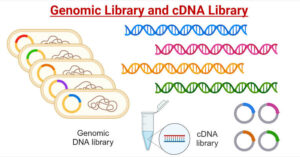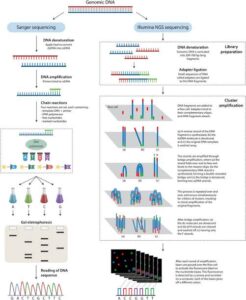Back to: MICROBIOLOGY 500 LEVEL
Welcome to class!
Hey there, superstar learner! It’s always a pleasure to have you back in class. I hope you’re ready for another exciting ride through the fascinating world of molecular biology. Today, we’re talking about a topic that has completely transformed science and medicine—Sanger Sequencing vs. Next Generation Sequencing (NGS). Don’t worry, we’ll keep it real and relatable. By the end of this class, you’ll be able to tell exactly how scientists read the “letters” of DNA—and how that knowledge is used to change lives across Nigeria and beyond.
Sanger Sequencing Vs. Next Generation Sequencing (NGS)
Let’s start with a quick story. Imagine you’re reading a novel. Sanger sequencing is like reading one page at a time—slow but clear. NGS, on the other hand, is like photocopying entire chapters at once and reading them all simultaneously—fast, powerful, and efficient!

Both methods are used to determine the order of nucleotides (A, T, C, G) in a DNA strand, but they differ in speed, cost, and scale.
Sanger Sequencing (First-Generation Sequencing)
This method was developed by Frederick Sanger in the 1970s and was the first reliable method for sequencing DNA. It uses a technique called chain termination, where special “stop” bases labelled with fluorescent colours are added during DNA replication. These stop the chain at various points, and a machine reads the colours to figure out the DNA sequence.
Key features:
Accurate and reliable for small DNA fragments (usually up to 900 base pairs).
Time-consuming and expensive for larger genomes.
Still used today for verifying short sequences, especially in diagnostics and cloning.
Real-life Nigerian example: Think of a tailor in Ibadan who sews one outfit at a time with perfect detail—slow but neat.
Next Generation Sequencing (NGS)
NGS refers to modern, high-throughput methods that allow scientists to sequence millions of DNA fragments at once.
Instead of doing one DNA piece at a time like Sanger, NGS breaks the whole genome into tiny pieces, sequences them all together, and uses computers to stitch the data back together.
Key features:
Extremely fast and can process entire genomes in a day.
Much cheaper per base than Sanger for large-scale sequencing.

Requires strong computational tools for data analysis.
Used for:
Studying cancer mutations
Tracing infectious diseases like COVID-19 variants
Research in personalised medicine and population genetics

Real-life example: Think of a large printing press in Lagos printing thousands of books at once—fast, efficient, and made for large-scale work.
Summary
- Sanger sequencing is accurate and best for short DNA segments but is slow and expensive for large projects.
- NGS is fast, scalable, and cost-effective for whole-genome and large-scale sequencing.
- Both are powerful tools used in medicine, research, and biotechnology.
Evaluation
- What is the main difference between Sanger sequencing and NGS in terms of speed?
- Why might a scientist still use Sanger sequencing today?
- Name one application of NGS in medical research.
You did a fantastic job today! You now understand how scientists read the “language” of life using both traditional and modern DNA sequencing methods. Whether it’s understanding sickle cell genes or studying viruses like Lassa or Ebola, this knowledge is helping researchers across Nigeria and the world solve real-life problems. Keep shining and learning with Afrilearn—you’re well on your way to becoming a world-class microbiologist! See you in the next class!
